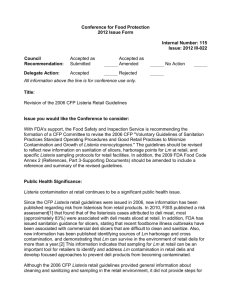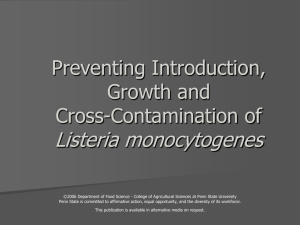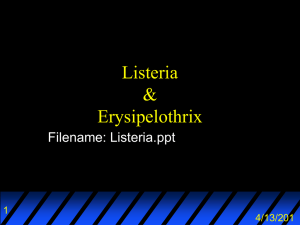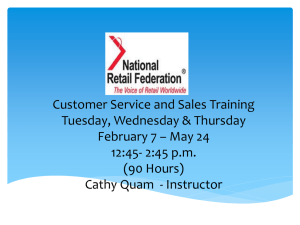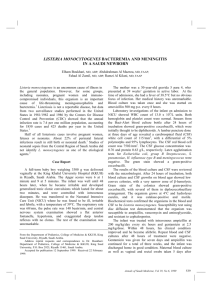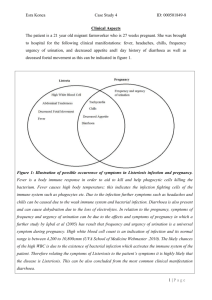USDA – Progress, Trends and Compliance
advertisement
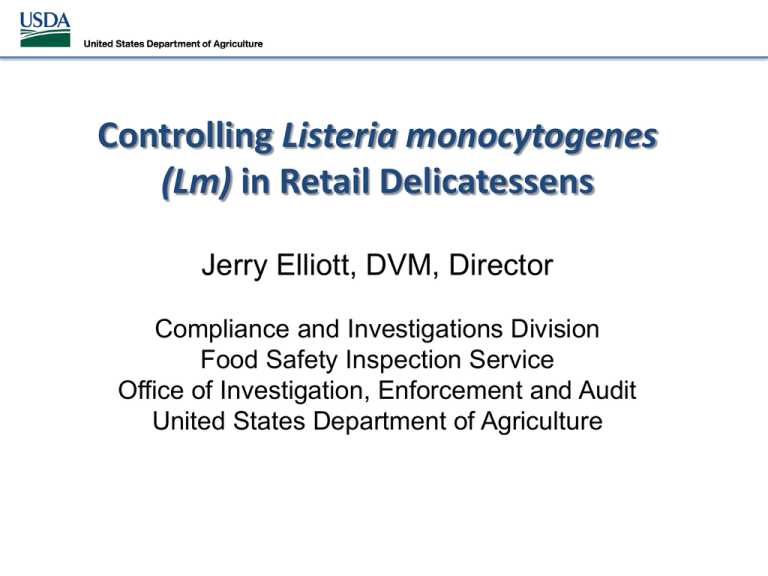
Controlling Listeria monocytogenes (Lm) in Retail Delicatessens Jerry Elliott, DVM, Director Compliance and Investigations Division Food Safety Inspection Service Office of Investigation, Enforcement and Audit United States Department of Agriculture What is Lm? • Bacterium found in moist environments, soil, and decaying vegetation • Transfer of the bacteria is a particular hazard of concern in ready-to-eat (RTE) foods 2 Listeriosis • Serious infection caused by eating food contaminated with the bacterium Lm • Rare, but high fatality rate (16% compared to 0.5% for Salmonella or E. coli O157:H7) • Affects older adults, pregnant women, newborns, and adults with weakened immune systems http://www.cdc.gov/listeria/statistics.html 3 Listeriosis • Symptoms: Fever, muscle aches, fatigue, • Estimated 1,600 illnesses, 1,500 hospitalizations, and 260 deaths in the United States each year http://www.cdc.gov/listeria/statistics.html 4 Regulation of Meat and Poultry Products at Retail • Food Safety Inspection Service (FSIS) shares jurisdiction at retail • The Federal Meat Inspection Act (FMIA) and Poultry Products Inspection Act (PPIA) • FDA makes recommendations regarding retail practices through the FDA Food Code 5 The Interagency Retail Lm Risk Assessment No single action or practice will control Lm contamination of retail foods. 6 Key Findings from The Interagency Retail Lm Risk Assessment 1. 2. 3. 4. 5. Storage Temperature Growth Inhibitors Control Cross-Contamination Control Contamination at its Source Continue Sanitation 7 1. Storage Temperature • If all refrigerated RTE foods are stored at 41°F (5°C) or below, approximately 9% of predicted Lm cases could be prevented 8 2. Growth Inhibitors • If all deli products that support Lm growth were reformulated to include growth inhibitors, could prevent 96% of predicted listeriosis cases 9 3. Control Cross-Contamination • Eliminating all points of cross-contamination would decrease the predicted risk of listeriosis by approximately 34% 10 4. Control Contamination at its Source • Elimination of environmental niches in the deli area will reduce the predicted risk of listeriosis in the retail deli 11 5. Continue Sanitation • Sanitation practices that eliminate Lm from food contact surfaces result in a reduction in the predicted risk of illness 12 Key Findings from The Interagency Retail Lm Risk Assessment 1. 2. 3. 4. 5. Storage Temperature – 41°F (5°C) or below – 9% Growth Inhibitors – 96% Control Cross-Contamination – 34% Control Contamination at its Source – decrease Continue Sanitation – gloves – 5% 13 Product Handling 14 Product Handling • Use products formulated with antimicrobial agents to eliminate or prevent the growth of Lm • Use products that have been treated to reduce pathogens • Monitor the shelf life of RTE products • Do not pre-slice products 15 Product Handling • Remove products that are likely to be considered adulterated • Promptly return RTE products to refrigeration • Maintain refrigeration units at or below 41°F • Store and handle RTE and raw products separately 16 Cleaning and Sanitizing 17 Cleaning and Sanitizing • Eliminate insanitary conditions • Develop written sanitation procedures • Document daily sanitation actions • Clean and sanitize frequently 18 Cleaning and Sanitizing • Clean and sanitize items routinely handled • Disassemble equipment to clean and sanitize • Follow the manufacturer’s recommendations for sanitizer strength and application • Change sanitizers to provide bacterial control 19 Cleaning and Sanitizing • Develop a procedure to sanitize cleaning aids • Use low water pressure • Use separate sinks • Eliminate or remove unnecessary items 20 Facility and Equipment Controls 21 Facility and Equipment Controls • Monitor conditions that could cause adulteration • No construction when exposed RTE product is present • Assure food contact surfaces are easily cleanable • Keep water from pooling • Keep overhead structures clean 22 Employee Practices 23 Employee Practices • Ensure that employees wear gloves • Train employees in sanitation practices • Provide adequate facilities for hand washing • Ensure ill employees do not work with open food items • Limit traffic in the deli area • Ensure employees change clothing when soiled 24 Resources • FDA Flyer: Keep Commercial Deli Slicers Safe, http://www.fda.gov/downloads/Food/GuidanceRegulation/UCM240674.pdf • FSIS Listeria Guideline http://www.fsis.usda.gov/PDFwps/wcm/connect/d3373299-50e6-47d6-a577e74a1e549fde/Controlling_LM_RTE_guideline_0912.pdf?MOD=AJPERES • Penn State Control of Listeria monocytogenes in Retail Establishments http://pubs.cas.psu.edu/freepubs/pdfs/uk137.pdf • FMI Listeria Action Plan for Retail Delis http://www.fmi.org/docs/food-safety-best-practice-guides/listeria-action-plan-forretail-delis.pdf?sfvrsn=9 25 Contact Info Jerry Elliott, DVM, Director Compliance and Investigations Division jerry.elliott@fsis.usda.gov 26
